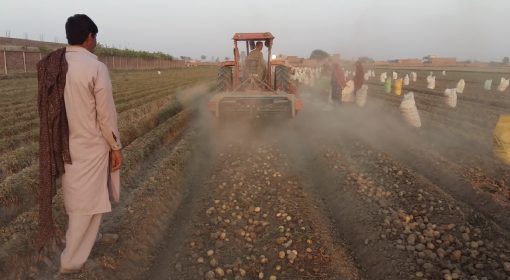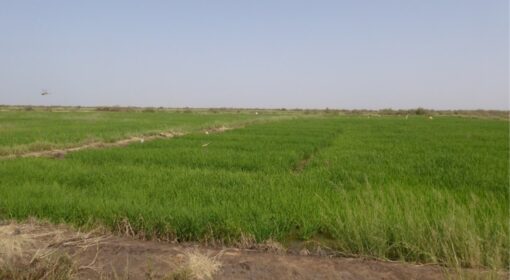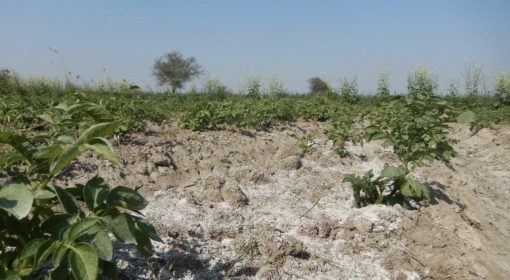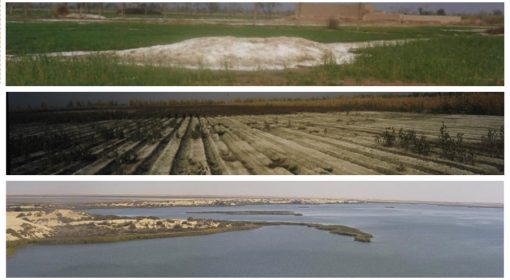By Marina Vara Gutiérrez and Simon Chevalking
The Salt Challenge
Are there options to make the best of these increasing saline conditions that the world is facing?
Worldwide over 1 billion hectares of land is salt affected. Each year soil salinization takes up to 1.5 million ha of farmland out of production and another total of 46 million hectares on which production potential is decreased (FAO, 2020). This land is believed to have either very low productivity or even be completely unproductive and crop damage caused by salinization is valued at $ 27 billion annually. Rural communities are forced to abandon these lands, destabilizing entire societies.
Pakistan, a country affected by land salinisation
In Pakistan, 6.2 million hectares of land are affected by salt. With limited freshwater resources available, farmers are forced to use brackish groundwater to water their crops, reducing the overall yields and quality. The point is that most farmers are not much aware of the possibilities of salt tolerant crops, there is a lack of knowledge about cultivating under saline conditions and these salt tolerant varieties are not available for them. The introduction of salt tolerant potato varieties in these areas in Pakistan has the potential to change this reality. Potatoes have a high ‘nutritional productivity’, meaning that with little water a high nutritional value is produced, making the crop very relevant and viable as fresh water is becoming a more and more scarce and valuable resource. Considering that we now have salt tolerant varieties, making it possible to cultivate these crops under saline conditions, growing them on salt affected soils can not only provide farmers in these areas with the tools they need to grow food but also secures their livelihoods.
What was done?
MetaMeta together with Salt Farm Texel and Jaffer Agro Services introduced salt tolerant potato varieties in Pakistan that can make a great contribution to food security for people dependant on these lands. The activities started in the 2014, when Salt Farm Texel, MetaMeta and Jaffer Agro Services were enabled to start up a project in Pakistan, that was part of the ‘Securing Water for Food’ Grand Challenge, supported by USAID, Sweden (through the Swedish International Development Cooperation Agency (SIDA) and the Ministry of Foreign Affairs of the Kingdom of the Netherlands.

For this activity Salt Farm Texel performed highly controlled field trials at the open-air laboratory in the Netherlands, together with Dutch potato breeders. After screening 300 potato varieties only, a few varieties were identified that showed high yields at high salinity levels (Table 1). These differences in salt tolerance are based on the natural variation in tolerance and all potatoes are non-GMO. The selected potato varieties were then shipped to Pakistan.

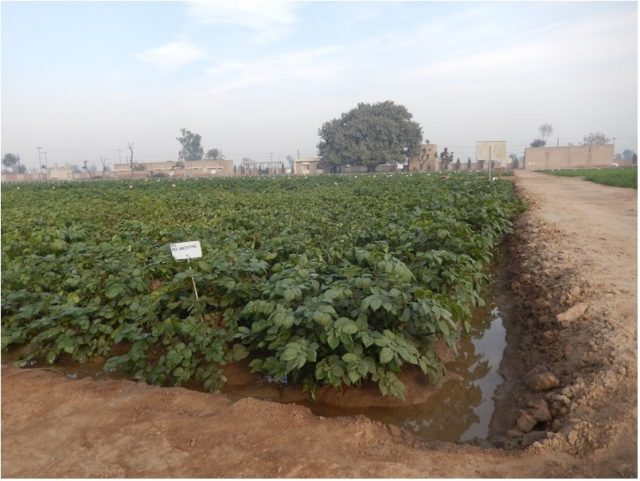
During three cropping seasons (2014-2015, 2015-2016 and 2016-2017) the selected salt tolerant potato varieties were planted together with the local potato variety in different plots of two areas of the Sindh and Punjab regions (Figure 1). During the three cropping seasons more than 100 hectares were cropped with salt tolerant potato varieties. In Sindh in proximities of Mirpur Khas (Nawazabad farm), Tando Allah Yar, Tando Jam, Hyderabad and in the proximity of Sanghar; in Punjab proximities of Depalpur, Sikandar Chowk – Alwardi, Okara and Sahiwal (Potato Research Institute) (Figure 2). Both areas are affected by salinity and in the Sindh region potato cultivation was impossible due to high salinity levels.


What we found: some potato varieties are more salt tolerant than what was earlier thought
Potato has for a long time been classified as a crop sensitive to salinity levels in soil and in irrigation water. Scientific literature described that a salinity level (EC) reaching 7 dS/m, when no extreme weather conditions occur, makes potato production unviable (Bustan et al., 2004). Salinity levels higher than 7dS/m affect plant growth, shoots and tuber production and hastens maturity (Levy, 1992; Nadler & Heuer, 1995). These assumptions were however based on very limited field trials with certain varieties and were not correct.

Soil salinity levels (EC) were sampled in trial plots in Punjab and Sindh during the two trial cropping seasons (2015-2016,2016-2017). The soil salinity was measured using the saturated soil paste salinity method. The results show a soil salinity level ranging from 7,54 to 9,1 dS/m with an average value of 8,49 dS/m. Comparing both trial regions, Sindh has even higher soil salinity levels (7,89 dS/m soil) than Punjab (8,7 dS/m soil) (Table 2). The differences within the same location between years is due to the selection of different farm plots and local spatial differences. Moreover, it is important to highlight that soil salinity is not a single valued parameter since the content of water in the soil is not constant overtime and influences the salinity levels.
Groundwater salinity measurements were recorded on the 2014-2015 cropping season. The results show an average value of 0,147dS/m in groundwater. This value indicates that groundwater in the trial areas does not exceed the recommended salinity values to be used in irrigation (0,7-2 slightly saline water, 2-10 dS/m moderate saline, 20-15 dS/m highly saline).
The soil salinity values obtained indicate that regular potato varieties are indeed unviable in the area with low yields at best. The introduction of salt tolerant potato varieties however totally changed the game.
Evidence from the field
Potato yields
During three cropping seasons (2014-2017) different salt tolerant potato varieties were trialled both in Punjab and Sindh. The results show that the average yield increase of the best performing varieties on both locations was 43% compared to the local variety (Sante), ranging from 28,14% (Red Valentine) to 89% (Miss Andes) yield increase. Moreover, the local potato variety (Sante) had an average yield of 14,5 tonnes/ ha while the average yields the trialled salt tolerant potato varieties was of 20,72 tonnes/ha. These values of salt tolerant potato varieties yield in salt affected soils equalled the government trials results of the productivity of Sante in non-saline soils (20 tonnes/ha). In the trial plots of both locations, the local potato variety (Sante) had an average yield of 14,5 tonnes/ha in saline soils while the salt tolerant potato varieties had an average yield of 20,72 tonnes/ha (Table 3).
In Sindh, a region characterised by high soil salinity levels in which potato cultivation was thought to be a non-starter, Festo was the highest yielding variety over the 3 trial years with an average yield of 23,5 ton/ha. This is a 76,5% higher productivity compared with the local variety Sante in Sindh (Table 3). In Punjab, Metro was the highest yielding variety over the 3 trial years with an average yield of 21,35 ton/ha. This is an increase of 46,13% productivity compared to the local variety Sante in Punjab (Table 3). However, Festo had an average yield of 20 ton/ha (36,9% yield increase), scoring as the third best salt tolerant yielding variety in Punjab.
Moreover, in cropping season 2015-2016, different plots were cultivated with old and new seeds of the salt tolerant potato varieties Miss Mignonne and Miss Andes. The results point out that new seeds provided a clear yield advantage. For instance, Miss Mignonne had a 95,12% yield increase compared to Sante using new seeds (Annex -Table 5). Old seeds of Miss Andes were 14,63% less productive than Sante, and Miss Mignonne was 1,2% more productive than Sante (Annex – Table 6).
The values do vary between different years and different locations, and therefore does not allow clear conclusions regarding the different performing productivity of salt tolerant potato varieties within different ranges of saline conditions. Sindh has more saline soil and groundwater than Punjab but not clear correlations with productivity levels can be found (Table 2, 3, 5, 6 & 7).
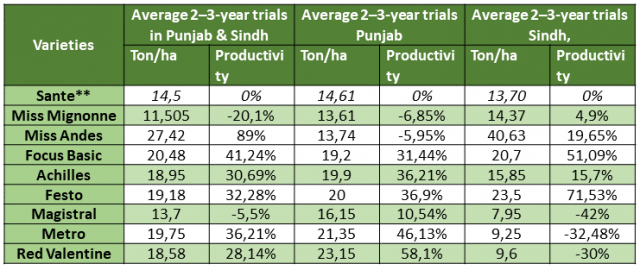
Water savings
During the three cropping seasons, most of the trial plots both in Sindh and Punjab were irrigated with tube well water or tube well water mixed with canal water. Tube well water in these areas contains salinity levels ranging from 2-10 dS/m or > 10dS/m (moderate to highly saline water). These salinity levels make tube well water unsuitable for human or irrigation use. Taken this into considerations, the plots which were irrigated with tube well water can be considered to have reached a 100% water savings level. Therefore, the introduction of salt-tolerant potato varieties in Pakistan will not only increase food security but will also reduce irrigation water consumption.
What happened after the three-year trials?
After the three-year trials in Punjab and Sindh, two containers were ordered and shipped to Pakistan with the salt tolerant potato variety Metro for the cropping seasons of 2017-2018 and 2018-2019.
Considerations
When importing a new crop variety to a country, there are certified procedures to comply with. These procedures were not transparent or clear during the project, hence only already certified salt-tolerant varieties, such as Metro, could be imported to Pakistan. On the contrary, other trialled varieties as Miss Mignonne were not certified in Pakistan. Moreover, when ordering the salt-tolerant potato varieties to the Netherlands it was logistically difficult to match the growing seasons of the two countries and received the shipment in Pakistan on time.
Take away points
- Salt tolerant potato varieties have the potential to make saline lands productive and competitive in Pakistan.
- The best performing salt tolerant potato varieties produces a yield increase of at least 28% with the most productive varieties reaching 89% yield increase.
- The best performing salt tolerant potato varieties produced and average of 6,22 tonnes/ha more than the local variety (Sante) in saline soils of Punjab and Sindh.
- The introduction of salt tolerant potato varieties has the potential to reduce irrigation water consumption thanks to the possibility to irrigate those crops with saline water.
- In Sindh – where temperatures are higher – the salt tolerant potato varieties had the additional advantage of capturing the market early.
- Consider the certification requirements regarding imported crops of each country.
- Consider how different growing seasons between the NL and the receiving country might affect the planting moment.
References
- Bustan, A., M. Sagi, Y. De Malach and D. Pasternak (2004). Effects of saline irrigation water and heat waves on potato production in an arid environment. Field Crop Research 90 (2-3):275-285.
- Bruns, S. and K. Caesar (1990). Shoot development and tuber yield of several potato cultivars under high salt concentration at different stages of development. Potato Research 33 (1):23-32.
- FAO, 1992. The use of saline waters for crop production.
- FAO, 2020. The future of food and agriculture. Trends and challenges.
- Levy, D. (1992). The response of potatoes (Solanum tuberosum L.) to salinity – plant growth and tuber yields in the arid desert of Israel. Annals of Applied Biology 120 (3):547-555.
- Levy, D. and R. Veilleux (2007). Adaptation of potato to high temperatures and salinity – a review. American Journal of Potato Research 84 (6): 487-506.
- Nadler, A. and B. Heuer (1995). Effect of saline irrigation and water-deficit on tuber quality. Potato Research 38 (2): 119-123.
Additional tables

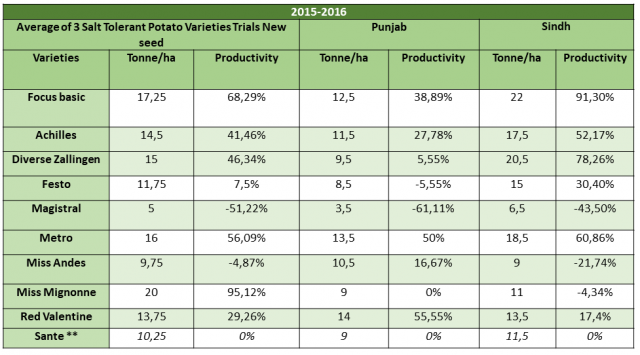

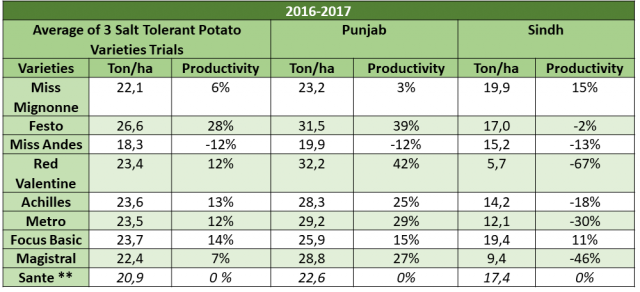
The work presented in this blog is implemented by:

